This post may contain affiliate links. Please read our disclosure policy. As an Amazon Associate, I earn from qualifying purchases.
This whole wheat einkorn bread has a mild, sweet, wheaty flavor with a subtle nuttiness that sets it apart from other breads. The einkorn flour gives it a rich, unique taste that will quickly become a family favorite.
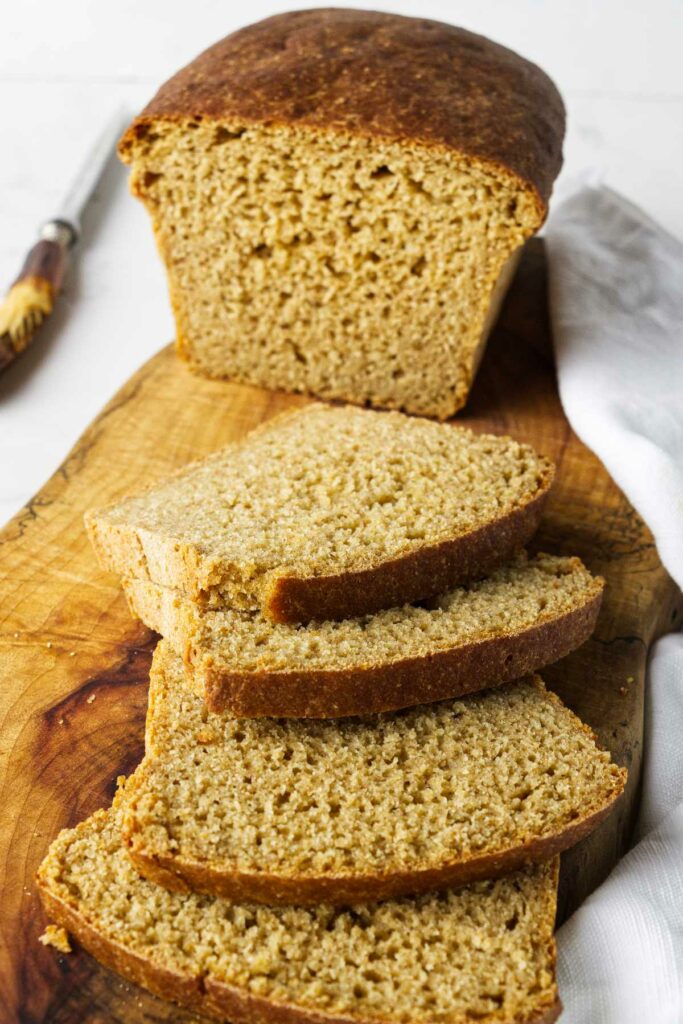
Einkorn is an ancient grain that is the oldest variety of wheat known. It was one of the first grains to be cultivated, and it has never been hybridized or genetically altered, so it has remained largely unchanged for thousands of years.
I like to think of einkorn as God’s original design for wheat. It is wheat in its most ancient and pure form, staying true to its origins. Its unique qualities and rich flavor make it stand out from modern wheat.
We have more bread recipes using einkorn, including einkorn sourdough bread, enriched einkorn sandwich bread, whole grain einkorn pizza dough, einkorn English muffins, and einkorn naan bread.
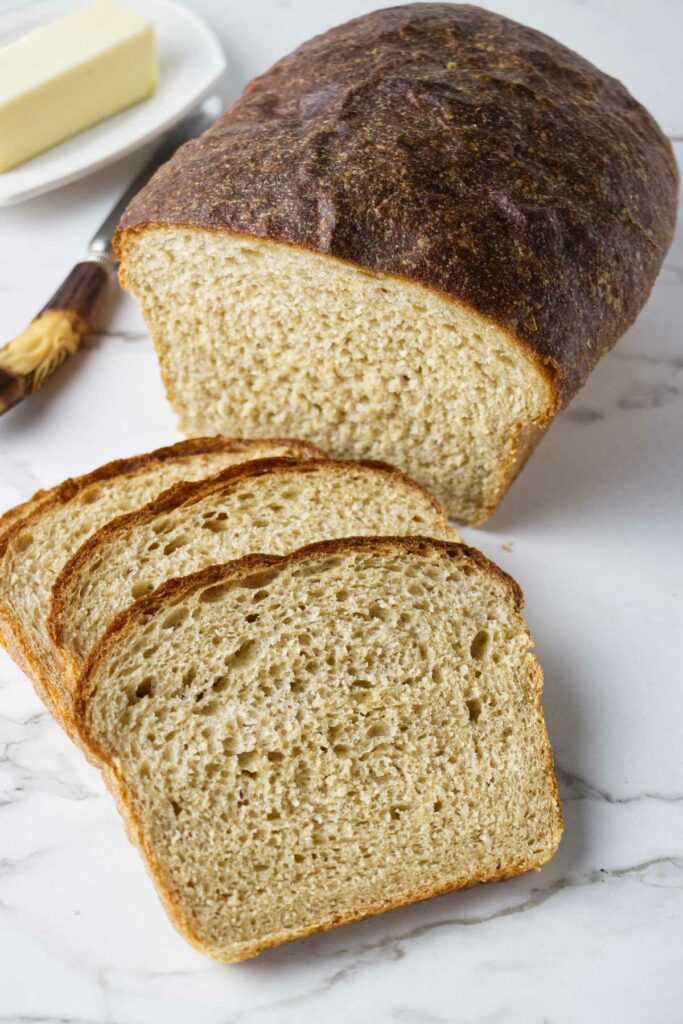
Why This Recipe Works
- This recipe uses a smaller ratio of yeast to give the dough more time to proof and develop flavor. However, we have instructions for quicker proof if you want bread today.
- This recipe gives you two options: a 100% whole wheat einkorn bread for a robust, traditional loaf, or a version with 75% einkorn flour that delivers the sweet wheat flavor of einkorn while creating a soft, fluffy bread with a tall rise.
- Since the gluten in einkorn does not develop with kneading, the 100% einkorn bread is a simple no-knead bread recipe. You don’t even need to bother with a stand mixer.
- The bread’s mild, wholesome wheat flavor and nutty notes become even more pronounced after a day or two.
- Einkorn’s unique qualities make it a standout choice for baking, offering a rich, wholesome flavor that sets it apart from modern wheat.
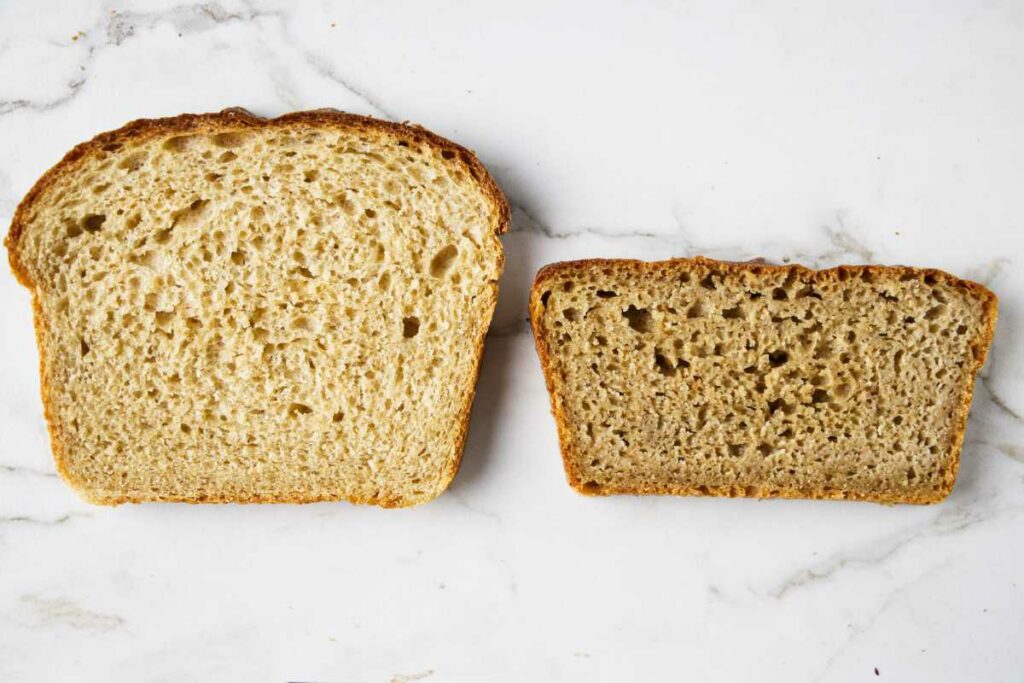
Baking Bread with Einkorn
This is a relatively easy recipe, but it is much different than baking bread with modern wheat. Even though einkorn has more protein than regular wheat, the ratios of the gluten proteins are much different, and the gluten in einkorn is very weak.
The weak gluten structure means:
- Bread made with 100% einkorn will not rise as high or get light and fluffy like Wonder Bread.
- If you make bread using all einkorn flour, you only want to let the final proof rise to between 30% and 50% of its height. Any higher and the bread will collapse when it bakes.
- When you make 100% einkorn bread, do not knead the dough. If you over-work the dough, the gluten will become even more fragile.
Some people add ginger or apple cider vinegar to the dough as an “old school” way to help enhance the rise of the bread. We do not recommend using either of these ingredients because the gluten in einkorn will not support a higher rise.
If you want your bread to rise higher and have a lighter, fluffier texture, you can replace some of the whole wheat einkorn with bread flour or add a couple of tablespoons of vital wheat gluten to the dough.
If you’re aiming to keep this bread focused on the qualities of einkorn, adding bread flour or vital wheat gluten can alter its unique character. However, it will still retain much of the flavor and texture that sets einkorn bread apart from loaves made entirely with bread flour.
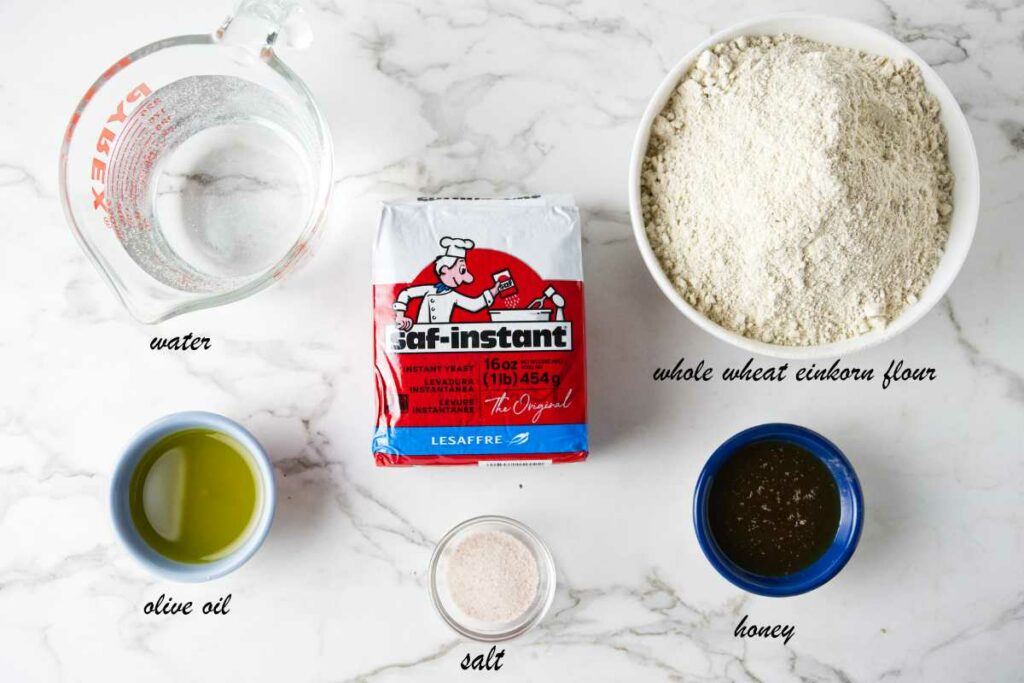
The Ingredients
Here is a list of the ingredients you will need for this recipe. Scroll down to the printable recipe card for all the details.
- Whole grain einkorn flour. This recipe works with freshly milled flour or commercially milled flour.
- Salt. The salt enhances the whole-grain flavor and brings out the sweet, nutty notes of the wheat.
- Instant dry yeast.
- Water.
- Honey. This recipe uses just enough honey to bring out the natural sweetness of the whole grain einkorn without making it a sweet bread.
- Extra virgin olive oil. Olive oil lends softness to the crumb and extends the shelf life by keeping it soft a little longer. If you use a good quality olive oil, hints of fruitiness from the oil will enhance the flavor of the bread.
How to Make It
Here is a brief overview to get an idea of what to expect with the recipe. Scroll down to the printable recipe card for all the details.
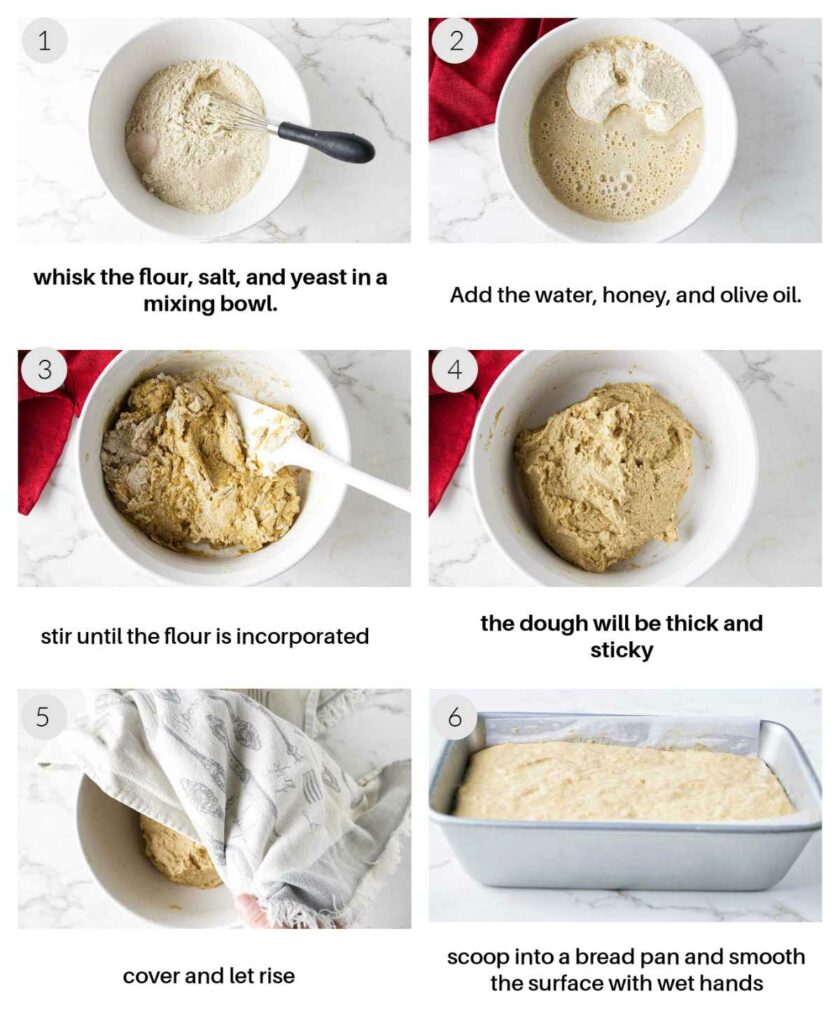
- Whisk the einkorn flour, salt, and yeast in a large mixing bowl.
- Add the water, honey, and olive oil. Stir well.
- Let the dough proof.
- Scoop the dough into the pan and smooth it out, then let it rise in the pan.
- Bake then let it cool completely before slicing.
If you want to make the recipe for 75% whole wheat einkorn bread, use the stretch and fold method to strengthen the gluten in the bread flour.
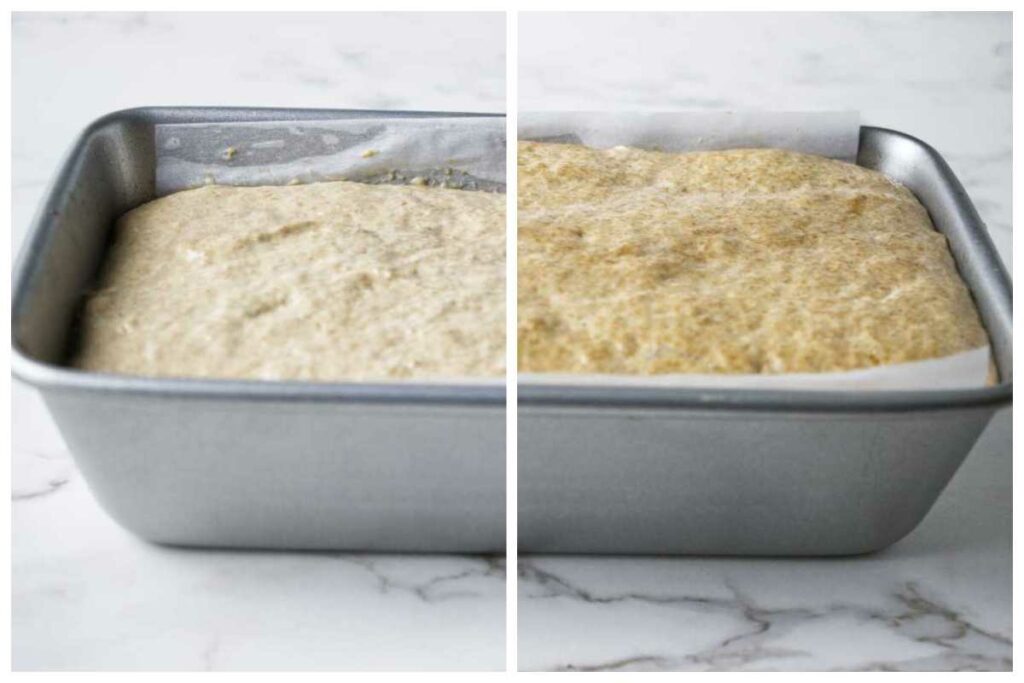
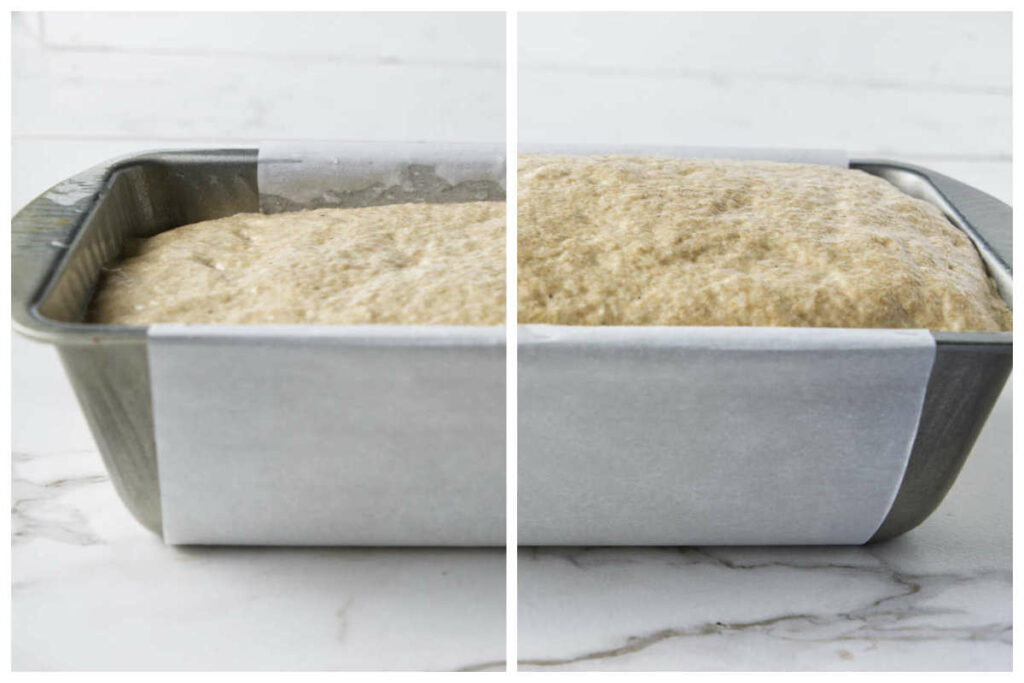
More Artisan Bread Recipes
Tips For Success
- Want to mill your flour? We recommend using a flour mill to mill your own flour. Food processors, blenders, and spice grinders don’t work as well as flour mills which will grind the flour more finely.
- If you have an instant-read thermometer, the interior of the bread should reach 205°F when it is finished baking.
- You will have more success with this recipe if you use a scale to weigh your ingredients. If you don’t have a scale, lightly spoon the flour into measuring cups and level it with a knife.
- The dough will be sticky and wet. Don’t add extra flour, or the bread will turn out heavy and dense. The sticky dough is a natural characteristic of einkorn. If you make the version with bread flour added, the dough will be easier to work with.
- Before handling the dough, moisten your hands with water so it won’t stick to you!
- Since einkorn flour has a weak gluten structure, aim to underproof the dough if you make the recipe for 100% einkorn bread. If you let this bread rise too much, it will collapse when you bake it. You only need to let the bread rise about an inch.
Substitutions and Variations
Add nuts or seeds. Toasted pumpkin or sunflower seeds are fantastic with this bread. Some other great options are anise seeds, caraway seeds, pistachios, walnuts, and hazelnuts. Add 1/2 cup of nuts or seeds to the bread dough if desired. The bread will be a little heavier and denser with nuts and seeds.
Add garlic and herbs. Garlic, with rosemary, thyme, or oregano, taste fantastic in this bread. Basil and sun-dried tomatoes is another great combination. Add 3 to 4 tablespoons of minced garlic or chopped herbs to the dough.
50/50 whole wheat einkorn flour and all-purpose einkorn flour. If you want to make this variation, use 240 grams of whole wheat einkorn flour and 240 grams of all-purpose einkorn flour. Follow the recipe as written, however, you can let the bread rise to 50% of its height (slightly more than the 100% whole wheat einkorn version).
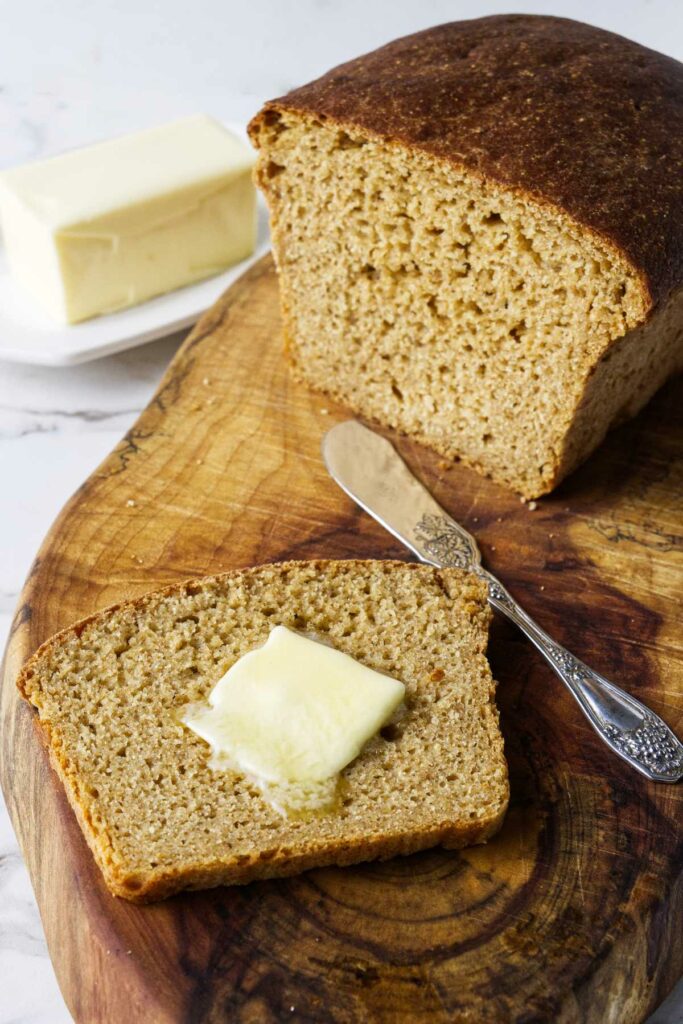
Storage
At room temperature: If you want to keep the crust soft, wrap it in plastic or keep it in an airtight container. If you prefer a crunchy, hard crust, store it loosely in a paper bag. It will keep up to 5 days on the counter.
Freezer: This bread will keep in the freezer for 3 to 6 months. Keep it wrapped tightly in freezer bags. I like to freeze individual slices and grab what I need for toast or sandwiches without thawing the entire loaf.
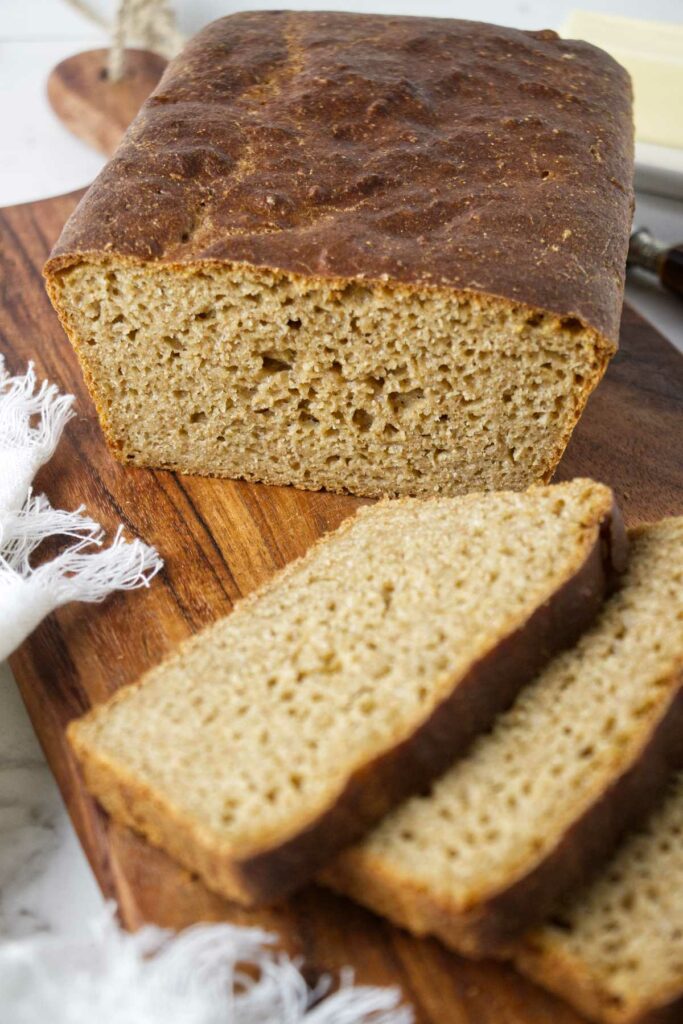
More Einkorn Recipes
If you love baking with einkorn, try these recipes:
- Einkorn chocolate banana muffins
- Einkorn pancakes
- Einkorn pasta
- Einkorn pumpkin cake roll
- Einkorn pie crust
- Einkorn crackers
- Einkorn chocolate chip cookies
- Einkorn brownies
- Einkorn almond cake
- Einkorn dumplings
- Einkorn risotto
More Recipes You Will Love:
Our barley quick bread is a hearty, rustic bread. It is easy to make and doesn’t require any yeast.
Spelt sourdough bread offers a rich, hearty wheat flavor with the added depth from the sourdough fermentation.
These kamut tortillas are soft and tender and so delicious. Kamut flour gives them a delicious flavor.
Pin this now to find it later!
Pin It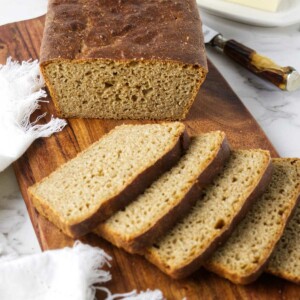
Whole Wheat Einkorn Bread
If you make this recipe, please leave a star rating and comment.
Ingredients
- 5 cups whole wheat einkorn flour, 480 grams
- 1 ¾ teaspoons salt, 11 grams
- ¾ teaspoon instant dry yeast, 3 grams, see notes
- 1 ½ cups water, 354 grams
- 3 tablespoons honey, 60 grams
- 3 tablespoons extra virgin olive oil, 37 grams
Instructions
For No Knead Whole Wheat Einkorn Bread
- Whisk the einkorn flour, salt, and yeast in a large mixing bowl.
- Add the water, honey, and olive oil. Stir until the dry ingredients are incorporated and a thick dough forms. The dough will be thick and sticky (almost like brownie batter).
- Spray the top of the dough with olive oil to prevent a skin from forming. Cover the bowl with plastic and let it rise at room temperature for 3 to 4 hours (if you place it in the fridge, you can let it proof for 6 to 8 hours to develop more flavor).
- Preheat the oven to 350°F and line a 9 x 5-inch bread pan or an 8 x 4-inch bread pan with parchment paper.
- Scoop the dough into the pan and smooth it out with wet hands. The dough will be sticky and wet but if you keep your hands wet, they will not stick to the dough.
- Let the bread rise for 30 to 60 minutes or until it is 30% to 40% taller. Do not let the dough double in height or it will collapse when it bakes. If you are using a 9 x 5 pan, let the dough rise approximately 1 inch (it can rise a bit taller if you have an 8 x 4-inch pan).
- Bake 38 to 48 minutes. If you have an instant read thermometer the internal temperature should be 205°F.
- Remove the bread from the loaf pan and place it on a wire rack to cool. Let the bread cool for 2 to 3 hours before slicing.
Notes
Nutrition
Nutrition information is automatically calculated, so should only be used as an approximation.
 Like this recipe? Rate & comment below!
Like this recipe? Rate & comment below!
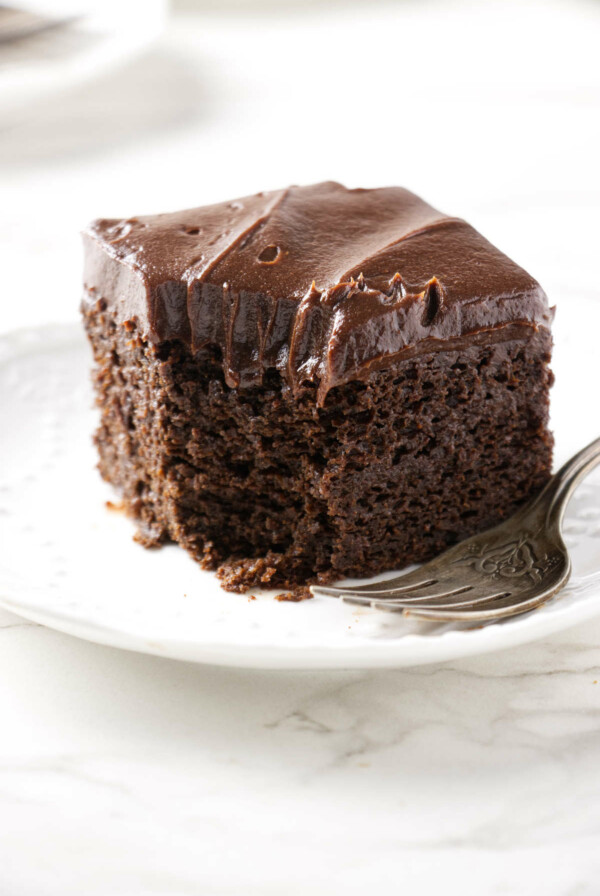
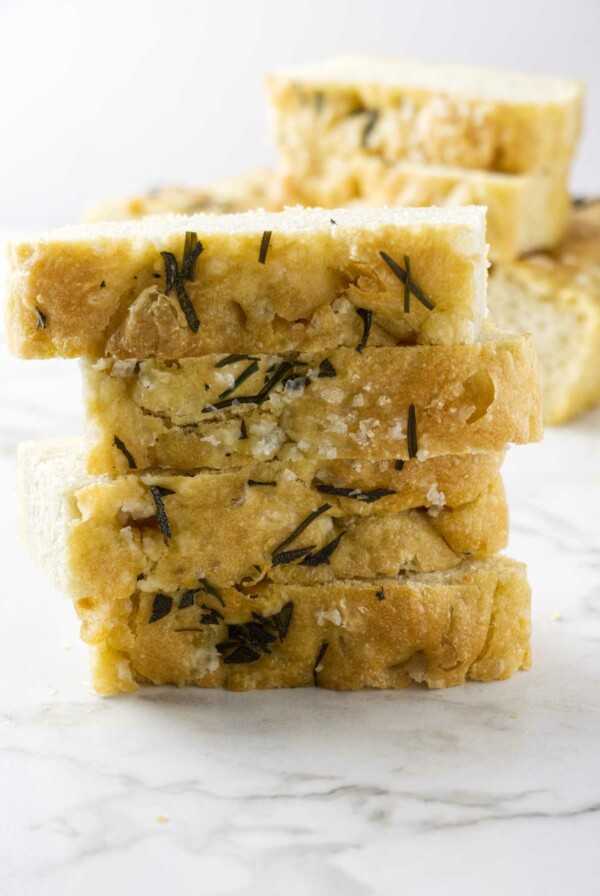
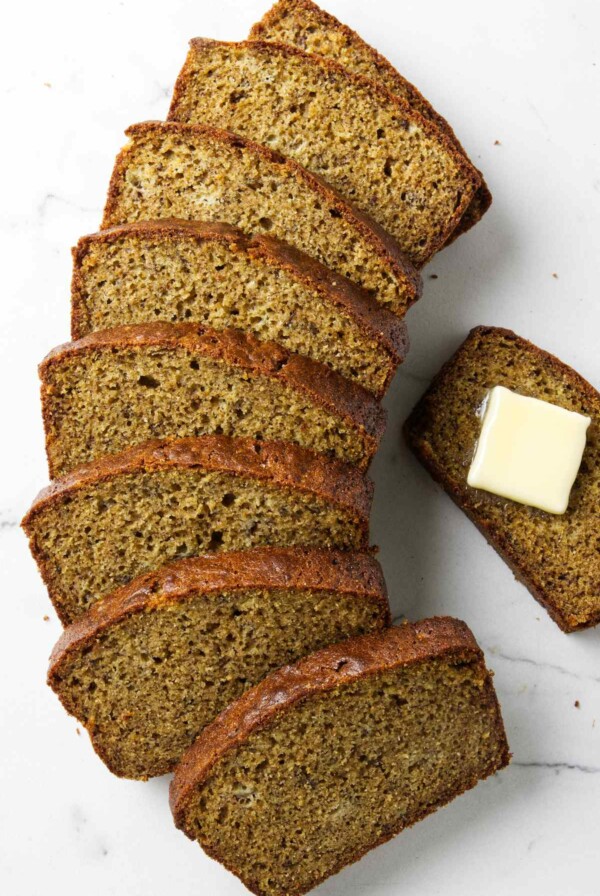
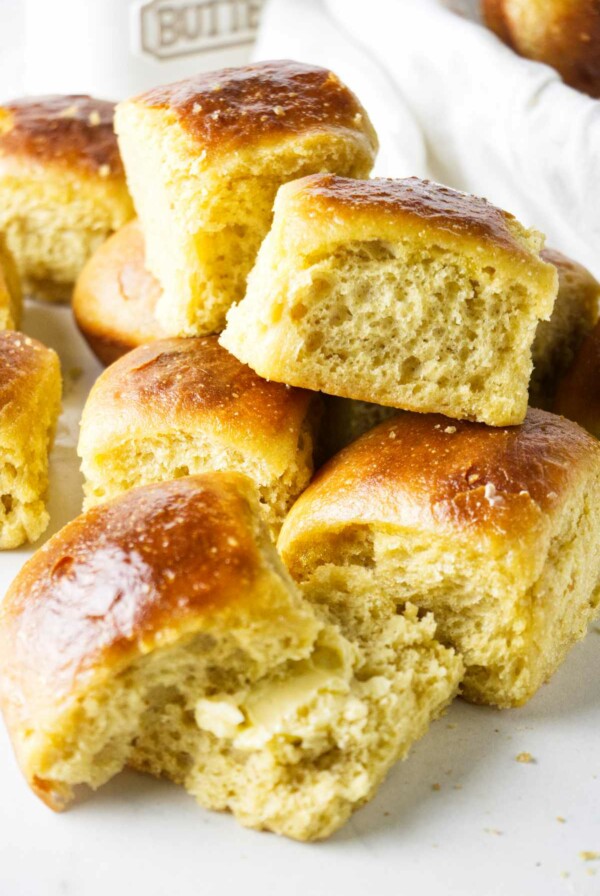

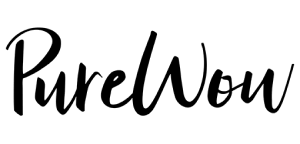








I’m a little confused, with the 75% version, is the other 25% ap einkorn or normal bread flour?
I can see how that was confusing. Thanks for catching it! I’ve updated the recipe to make it clearer. The main recipe is written for 100% whole wheat einkorn bread, but there’s now an option in the notes if you’d like to replace about 25% of the whole wheat einkorn flour with all-purpose einkorn or regular all-purpose flour for a lighter loaf.
Thanks for the update. I made it with the all purpose flour, but it didn’t rise well even when given extra time, and had a dense crumb.
Any tips on getting it to rise? What temp should the water be? Should I knead it at all?
Thanks 🙂
Thanks for following up! Einkorn can be tricky because its gluten behaves so differently from modern wheat. Even with a portion of all-purpose flour, the dough won’t rise as high as a regular wheat loaf.
A few things that can help:
Keep the water temperature around 100–105°F.
As far as mixing goes, Einkorn doesn’t need traditional kneading. Just stir or fold it just until the flour is incorporated, then give it a rest to hydrate.
Adjust the rise time as needed. Go by how the dough looks rather than the clock. It should puff up, but it won’t double like regular dough.
If you’d like a lighter loaf, try increasing the regular all-purpose flour a bit more or use bread flour which has a stronger gluten.
Once you get a feel for how einkorn behaves, it becomes much more predictable!
Just wanted to share that I have tried both of these versions with 100g of sourdough starter instead of active yeast & just reduced the flour by 50g & the water by 50g. They both turned out amazing!
100% whole wheat would be:
No active yeast
100g starter (add with wet ingredients)
430g of whole grain einkorn flour
304g water
The rest of the ingredients stay the same
Follow recipe as directed by author
75% whole wheat would be:
No active yeast
100g starter (add with wet ingredients)
310g of whole wheat einkorn flour
120g bread flour (I used AP Einkorn)
304g water
The rest of the ingredients stay the same
Follow recipe as directed by author
I hope this helps my fellow sourdough einkorn lovers out there!
This is fantastic. Thank you for sharing your sourdough adaptation! I love that you took the time to test both versions and provided such clear measurements. Einkorn and sourdough can be tricky to balance, so I know this will be super helpful for others who want to try a naturally leavened version. I appreciate you sharing your experience!
Thank you for sharing this, Stephanie, I’ll be trying it today! It’s so great to have some tried-and-true instructions to follow.
Fantastic recipe! I made the recipe with 75% freshly milled whole grain Einkorn and 25% AP Einkorn and used a mixture of butter and olive oil for the oil with one full packet of instant yeast to speed up the process and the loaf turned out amazing. Beautifully soft and moist with a lovely crumb and crust. Hubby and I immediately devoured half the loaf.
Thank you so much! I’m thrilled you and your husband enjoyed it! I also love using freshly milled flour. It really makes a difference, doesn’t it? Thanks for the comment.
Can I use fresh yeast instead of dry?
Yes, if you use fresh yeast, double the amount called for in the recipe. Thanks for the question.
Can you use 1 cup of all purpose einkorn, instead of the 1 cup of bread flour? Would that give a softer, lighter loaf of bread? Which recipe directions ( the 100% or the 75% recipe) would you follow using this modification?
Yes, if you follow the 75% whole grain recipe, you can swap the bread flour for all purpose einkorn flour. The all purpose einkorn will help give the bread a lighter texture but not as light and fluffy as if you use bread flour but if you are after a 100% einkorn bread, that will work well. Thanks for the question, I will update the recipe card to reflect this option.
Can I use active dry yeast instead of instant yeast? I accidentally bought active instead of instant.
Thanks!
Absolutely! Anytime you want to use active dry yeast for a recipe that calls for instant yeast, just use 25% more. In this case you will want to use 1 teaspoon or 3.75 grams of active dry yeast for the einkorn bread. You will need to activate the yeast first by adding it to 1/4 cup of warm water along with 1 teaspoon of sugar then let that sit for 5 to 10 minutes. After that, you can proceed with the recipe but you may want to reduce the water in the recipe by 1/4 cup. Thanks for the question.
Can you use honey instead of sugar for the active yeast? Also do you mix the water and honey together before adding to the flour mix?
Yes, you can swap the sugar for honey. Mix the honey with the warm water first to help it dissolve and evenly distribute. Thanks for your question.
@Dahn Boquist,
Perfect! Thank you!
Hello, I was wondering if you got it all mixed up if you could leave it in the fridge overnight and bake it in the morning. By the way thanks so much for your recipe. I love einkorn.
In theory you can. I have done that with other bread recipes but I have not tried it with this einkorn bread so I can’t say how it would turn out. The fridge will slow down the yeast activity and prevent it from over-proofing. However, the yeast will still have some activity and proof the bread slightly. If einkorn bread proofs too much then it will collapse during the bake. It all comes down to how much the bread rises when it is in the fridge. On the other hand if it doesn’t rise enough, then you will need to let it sit on the counter in the morning until it warms up enough for the bread to rise.
All that to say that it will be a bit of an experiment but I’m betting that it will work just fine.
Really? No oven temp?
Oven temp is 350°F.
We adore einkorn and use it a lot in my baking. Your bread looks wholesome, Dahn.
Thanks Angie